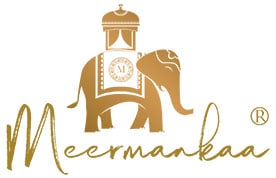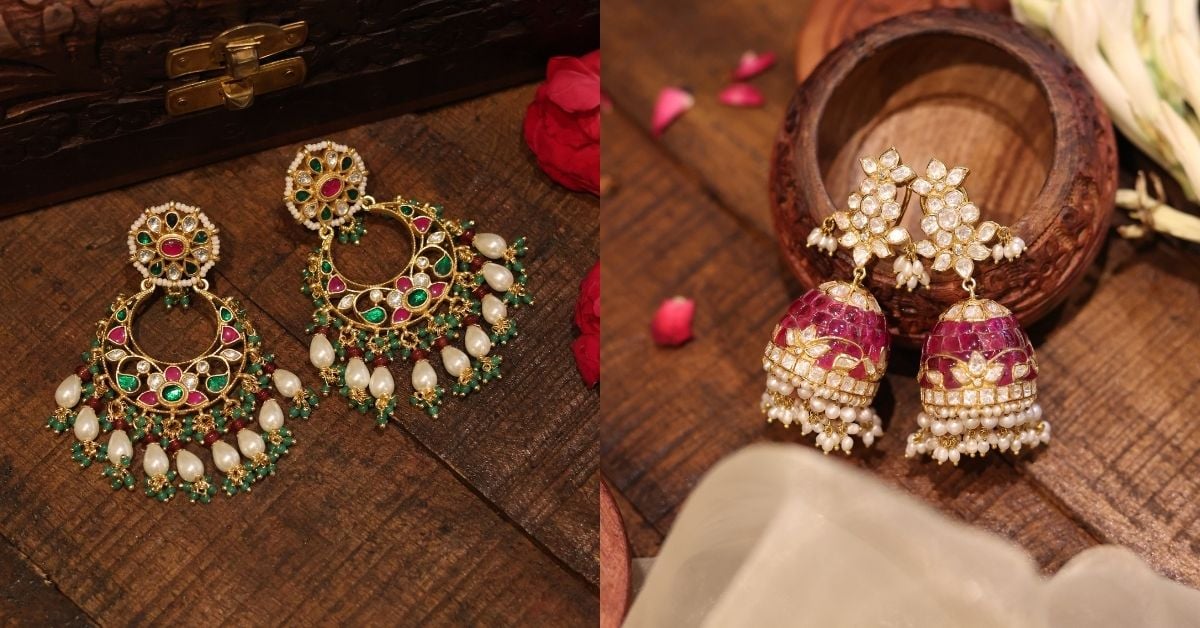Style
Jhumka vs Chandbali Earrings: A Complete Style Comparison
India is known for its rich jewellery heritage, offering countless styles and beautiful designs. Among them, jhumkas and chandbalis are two of the most loved earring types. These earrings have been worn for centuries, admired for their craftsmanship and cultural roots.
Jhumkas are shaped like small bells and add a playful touch to any outfit, while chandbalis, shaped like the moon. These earrings are often seen in weddings, festivals, and special celebrations. Though they come from different regions and times, both styles continue to be a favorite choice for women today.
In this blog, we’ll look at how jhumkas and chandbalis differ in their design, history, and styling, helping you decide which one matches your taste and outfit the best.
What are Jhumka Earrings?

Jhumka earrings are one of the oldest and most loved jewellery pieces in India. The name comes from the word “jhumki,” which means small bells. These earrings are shaped like a dome or bell and are designed to move with you, catching the light beautifully.
Jhumkas are renowned for their lively appearance and the slight jingling sound they produce.
Key Features of Jhumkas
- Dome or bell-shaped design that creates movement
- Often layered or tiered for a fuller look
- Decorated with pearls, beads, or small drops
- Commonly made in gold, silver, brass, copper, alloys, and plated metals.
How to Style Jhumkas?
Jhumkas are best paired with traditional outfits like sarees, lehengas, and anarkalis. For weddings or festive functions, large Jhumkas with enamel or gemstone detailing make a bold statement. For smaller celebrations or daytime events, you can pick simpler designs that are lightweight and easy to wear.
If you prefer to go light on the earrings, smaller Jhumkas also look beautiful with Indo-Western outfits like long skirts or even crisp shirts. To keep the focus on your earrings, avoid heavy neckpieces. The Jhumka itself is enough to complete your look.
What are Chandbali Earrings?
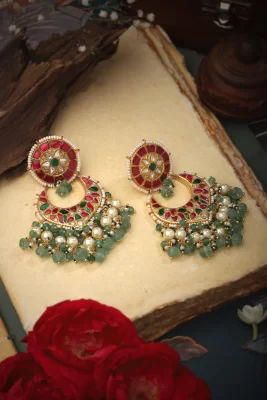
Chandbali earrings get their name from two Hindi words, “Chand,” meaning moon, and “Bali,” meaning earrings. The crescent shape gives them a beautiful and royal look.
The design has its roots in the Mughal and Rajput eras, where queens and royal women wore them as a sign of beauty and power. These earrings often have fine detailing with pearls, crystals, or Kundan work, giving them a soft glow that mirrors the moonlight. They represent romance, sophistication, and timeless allure.
Key Features of Chandbalis
- Crescent or half-moon shape
- Often double-layered or tiered for depth
- Embellished with pearls, Kundan, or crystals
How to Style Chandbalis?
Chandbalis are ideal for weddings, receptions, or formal evening events. Their structured design pairs beautifully with traditional outfits like heavy sarees and lehengas. For a softer balance, style them with hairstyles such as sleek buns, updos, or soft curls that frame the earrings well.
You can also wear minimal Chandbalis with simpler outfits like gowns or Indo-Western looks. If your outfit has a heavy neckline, pick smaller Chandbalis so that your look remains balanced.
The Difference Between Jhumka and Chandbali
Jhumkas have a long and fascinating history that traces back to ancient India. Over time, jhumkas became an essential part of Indian bridal jewellery and festive wear. Chandbalis, on the other hand, originated during the Mughal era.
The main difference between a jhumka and a chandbali is their shape and design. Jhumkas have a bell or dome shape that sways with you. They often include multiple layers or tiers with dangling beads or pearls at the edges. Modern variations now include fusion jhumkas, oxidized silver jhumkas, pearl jhumkas, and even minimalist jhumkas with a single layer.
Chandbalis, on the other hand, have a crescent moon shape that stays closer to the ear and gives a more regal and composed look. They are generally heavier in appearance but can vary from light everyday wear to grand bridal pieces.
Jhumkas, once made only of gold, now come in silver, brass, oxidized metal, pearls, and terracotta. Traditional temple jhumkas feature goddess motifs, while modern ones use crystals and enamel. Chandbalis showcase Kundan, Polki, or Meenakari work with colorful stones and pearls. Gold and rose gold suit brides, while silver versions fit festive looks.
You can wear Jhumkas with festive sarees, bright lehengas, or even simple kurtas. Chandbalis go well with gowns, shararas, or heavily embroidered outfits for special occasions. Both designs suit a range of face shapes and styles, so it’s best to have both in your collection.
How to Choose Between Jhumkas and Chandbalis?
Choosing between the two depends on your face shape, the occasion, and your personal preference.
For Face Shape:
- Round faces look longer with Chandbalis, as their crescent shape adds height.
- Oval faces suit both styles equally well.
- Square faces look softer with rounded Jhumkas.
- Heart-shaped faces balance out beautifully with small Jhumkas or light Chandbalis.
For Occasions:
- Choose Jhumkas for day events, festive gatherings, or temple functions.
- Pick Chandbalis for weddings, receptions, or evening parties.
Explore Chanbalis and Jhumkas at Meermankaa
At Meermankaa, you will find a wide range of both jhumka earrings and chandbali earrings. What makes Meermankaa’s jewellery special is the quality of materials and the beauty of handwork. Our range of gold-plated silver earrings offers durability with a premium finish.
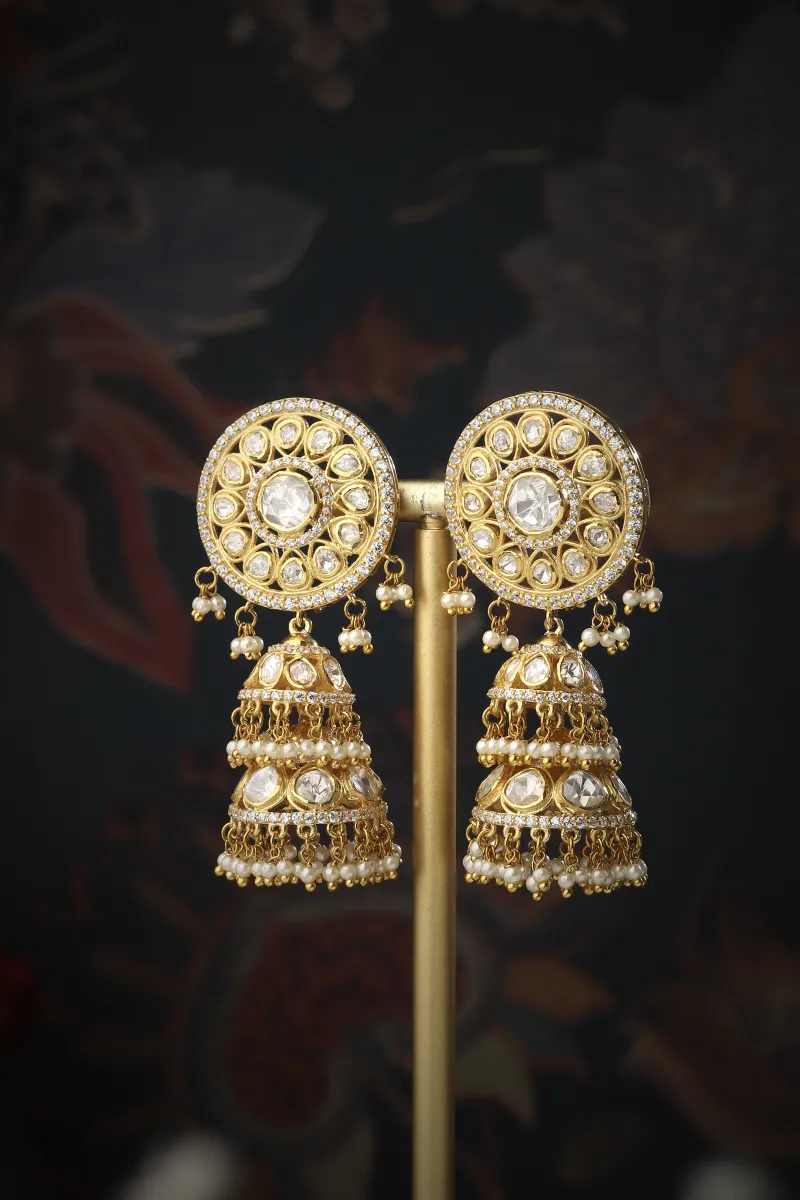
Explore a wide variety of designs, including Moissanite Polki Jhumkas, Meenakari Jhumkas, two-tier and multi-tier Jhumkas, temple Jhumkas, and enamel Jhumkas. Many pieces feature intricate Meenakari (enamel) detailing, temple motifs, or floral patterns. The range offers both lightweight styles for daily wear and elaborate designs perfect for bridal or festive occasions.
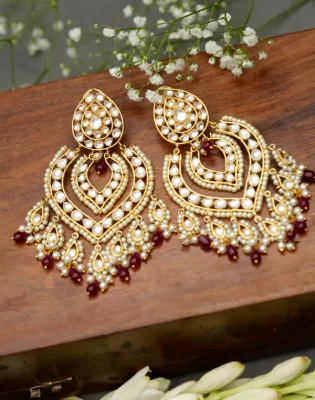
We also offer an exquisite selection of Chandbalis crafted in Kundan, Polki, pearls, and colored gemstones. Many designs showcase fine enamel work and delicate filigree. The collection includes Moissanite Polki Chandbalis, double-layer Chandbalis, and triple-layer Chandbalis.
Conclusion
You don’t really have to choose between jhumka earrings and chandbali earrings. Both of these earring types offer different details and add varying styles to your outfit. You can always experiment with other designs in these two earring types to complement your outfit perfectly.
If you are ready to add beautiful pieces to your jewellery box, explore the beautiful handcrafted designs at Meermankaa.
